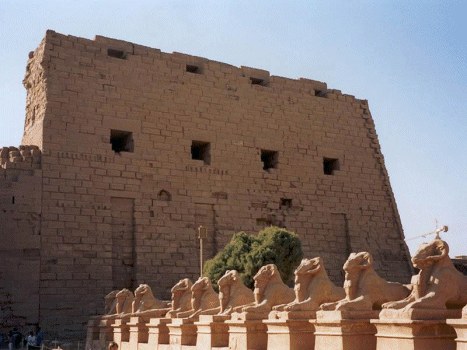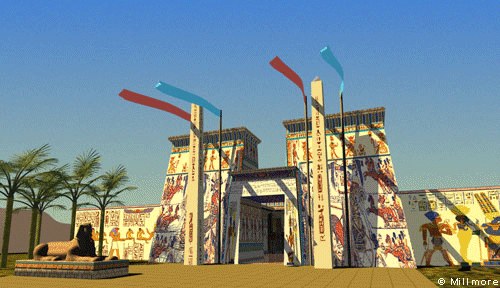The two large walls we are approaching are referred to as the First Pylon. Pylon comes from the Greek and means gateway. The first pylon of Karnak measures 113 meters (371 ft) wide, 15 meters (49 ft) deep, and 43 meters (141 ft) high. It dates from the Ptolemaic Period which may account for its lack of decoration.
 A fact that you may find interesting is that Egyptian temples are built to reflect the cosmos in miniature — well, miniature compared to the cosmos. The roof represents the sky and is generally painted with stars and flying birds that represent protective deities. Similarly, the floor symbolizes the great marsh from which the world arose. Thus, the lower portion of the walls and the floor are painted with papyrus, lotus, palms, aquatic birds, and animals. In addition, the center of the temple is generally raised to represent the primeval mound. A fact that you may find interesting is that Egyptian temples are built to reflect the cosmos in miniature — well, miniature compared to the cosmos. The roof represents the sky and is generally painted with stars and flying birds that represent protective deities. Similarly, the floor symbolizes the great marsh from which the world arose. Thus, the lower portion of the walls and the floor are painted with papyrus, lotus, palms, aquatic birds, and animals. In addition, the center of the temple is generally raised to represent the primeval mound.
 As to the pylons, the towers on either side of the entrance represent the two mountains of the horizon between which the sun arises each morning. In fact, there is an inscription on the Temple of Edfu that calls the pylons "Isis and Nephthys who raise up the sun god who shines on the horizon." As to the pylons, the towers on either side of the entrance represent the two mountains of the horizon between which the sun arises each morning. In fact, there is an inscription on the Temple of Edfu that calls the pylons "Isis and Nephthys who raise up the sun god who shines on the horizon."
 The recesses running vertically down the wall are for flagpoles. Flags always fly at our temples to announce the presence of the Divine. The recesses running vertically down the wall are for flagpoles. Flags always fly at our temples to announce the presence of the Divine.



|

